- Department of ECE publish paper on Fourier holography May 27, 2022
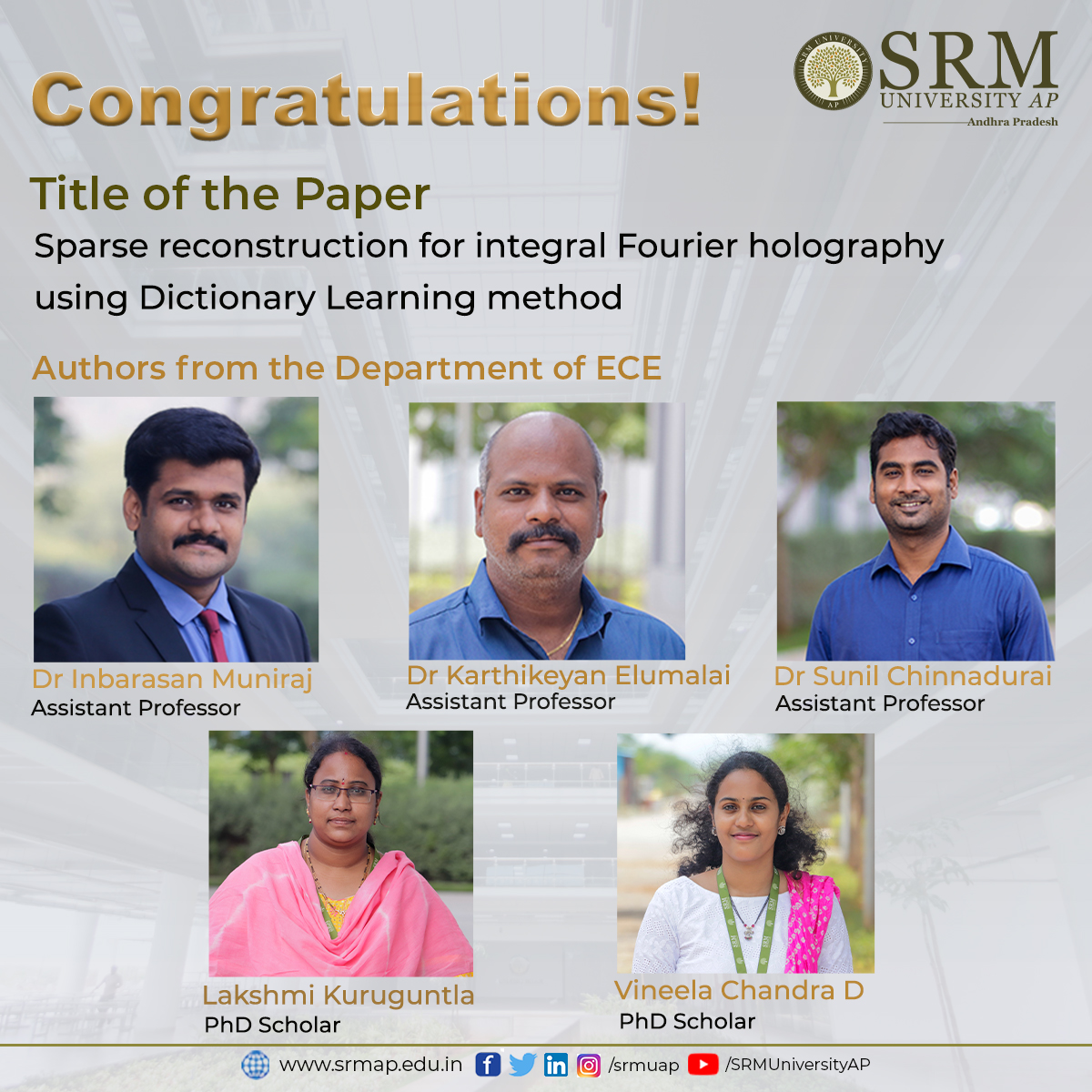
A paper titled “Sparse reconstruction for integral Fourier holography using Dictionary Learning method” has been published by Dr Inbarasan Muniraj, Dr Karthikeyan Elumalai and Dr Sunil Chinnadurai – Assistant Professors of Electronics and Communications Engineering at SRM University-AP, along with PhD students Lakshmi Kuruguntla and Vineela Chandra Dodda.
The paper proposes reconstructing holograms from fewer data, thereby reducing the need for processing the complete hologram data, which is otherwise computationally expensive.
Abstract: A simplified method was demonstrated to generate a hologram from multiple two-dimensional (2D) images. Sparse reconstruction was shown using the Sequential Generalised K-means (SGK) algorithm. It is shown that the proposed sparse reconstruction method provides a good hologram quality, in terms of peak signal-to-noise ratio, even under ~90% sparsity.
The paper is written in collaboration with Professor John T Sheridan, Vice-Principal for Research & Innovation – College of Engineering & Architecture, Head of School of Electrical and Electronic Engineering, University College Dublin, Ireland.
Holography has been shown useful for biomedical imaging, cryptography, data storage, and entertainment. The future plans of the research group include extending this approach to other holographic systems such as digital holography and holographic microscopy.
Continue reading → - Co-edited and authored in the world’s longest-running science journal May 27, 2022

Dr Soumyajyoti Biswas, Assistant Professor, Department of Physics, had two lucky breaks as he got his article “Kinetic Exchange Models of Societies and Economies” featured in the prestigious journal Philosophical Transactions of the Royal Society A, the theme issue co-edited by Dr Biswas himself, along with Dr Guiseppe Toscani from the University of Pavia, and Dr Parongama Sen from the University of Calcutta. Philosophical Transactions of the Royal Society has the prestige of being the world’s longest-running science journal launched in 1665. Publishing high-quality theme issues on topics of current importance and general interest within the physical, mathematical, and engineering sciences, the journal continues its history of influential scientific publishing.
A kinetic model of binary interaction, with conserving or non-conserving exchange, has been an elegant and powerful tool to explain collective phenomena in myriad human interaction-based problems, where an energy consideration for dynamics is generally inaccessible. Nonetheless, in this age of Big Data, seeking empirical regularities emerging out of collective responses is a prominent and essential approach, much like the empirical thermodynamic principles preceding quantitative foundations of statistical mechanics.
Through this theme issue, the authors intend to bring together the current progress in the applications of kinetic exchange models in various applications of societies (opinion formations, rating, social networks, fake news, etc.) and economies (inequality measures, taxation, trade models, behavioral economics, etc.) using numerical simulations, machine learning techniques, analytical methods, and data analysis, reported by physicists, social scientists, mathematicians and economists through some of the original and reviewed articles.
In human interactions, such as a trade (exchange of money) or, discussions or debates (exchange of opinions), following simple dynamical rules, a collection of agents (a society) shows emergent properties that are widely seen in real data (distributions of wealth, formation of consensus, etc.). Without knowing the complexities that are involved at the individual levels, it is, therefore, possible to understand the average properties of the society as a whole. This is reminiscent of simple elastic collisions of ideal gas molecules that give average thermodynamic properties, such as temperature, pressure, etc. without knowing the complexities of the individual atoms. This has been a widely followed route to formulate statistical physical models of societies and economies.
The kinetic exchange models have been a very successful set of tools to understand the socio-economic emergent properties from simple models. Among other things, these models helped understand the growth of economic inequalities, the effects of taxes as well as the spread of opinions. A close quantitative resemblance with real data from various countries of the world demonstrates its usefulness.
The future prospects of the kinetic exchange models for societies and economies include possible predictions of extreme fluctuations in average measurable quantities by looking at the inequality of time series data. The models can help us in identifying the features of the real data that can mirror the underlying extreme fluctuations.
Continue reading → - Evaluating workplace well-being May 27, 2022
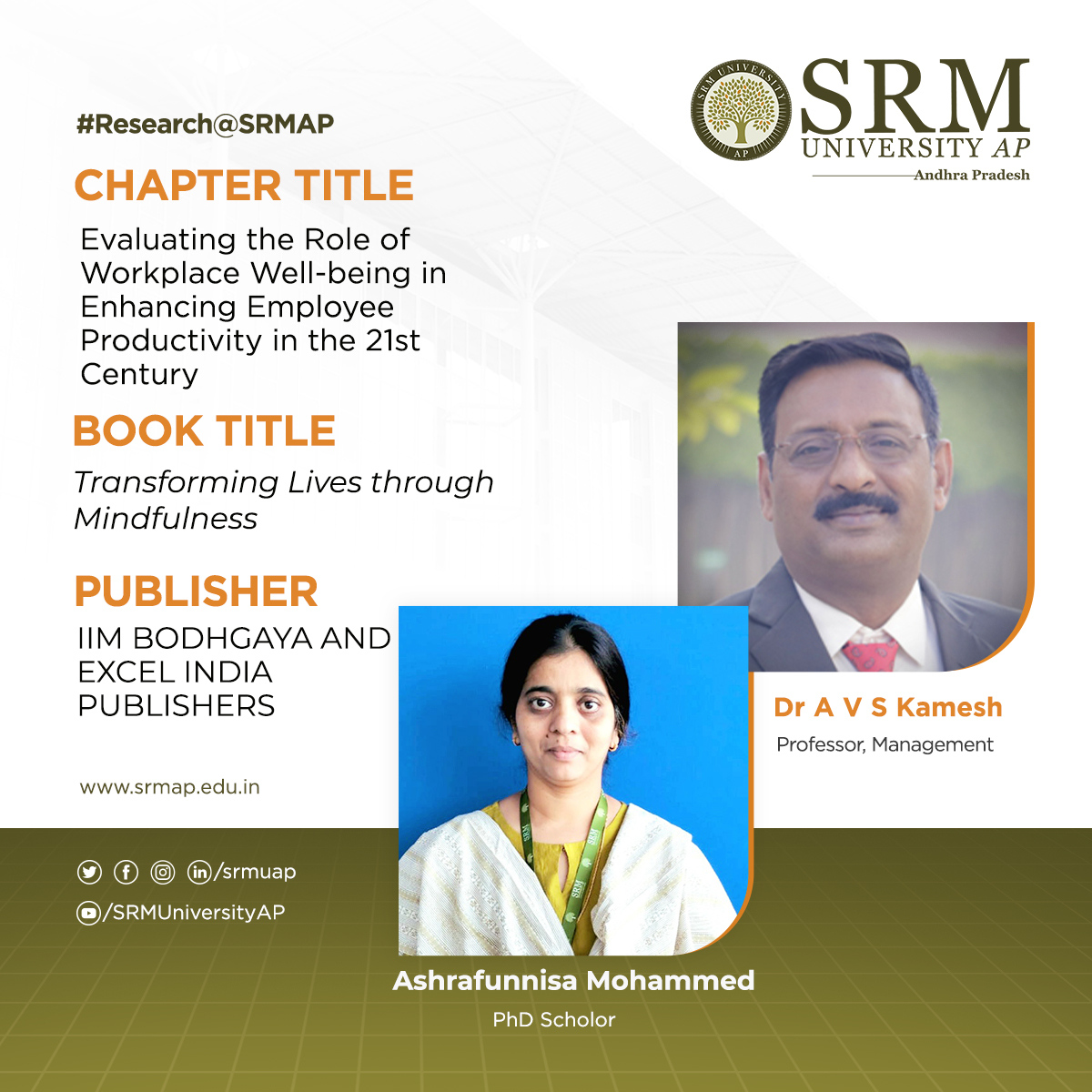
Employee wellbeing and productivity of the organisation are closely interlinked concepts mutually impacting each other in the long run. The idea of workspace wellness and health promotion has been making rounds in recent times, and the outset of the coronavirus pandemic has given added importance to the topic. Having conducted intense study in this regard, Prof AVS Kamesh and his PhD scholar Ms Ashrafunnisa Mohammed from the Department of Management have authored a chapter titled ‘’Evaluating the Role of Workplace Well-Being in Enhancing Employee Productivity in the 21st Century’’, in book Transforming Lives through Mindfulness published by IIM Bodh Gaya AND Excel India Publishers.
Their study tries to evaluate the unique role of workplace well-being in enhancing employee productivity in the 21st century. The contemporary business world is characterised by organisations competing against each other. In a dynamic and complex business environment, the main aim of modern corporate organisations is to retain talented employees by ensuring mindfulness and workplace well-being because these employees are the main sources of competitive advantage from a strategic point of view. Thus, an enhanced level of workplace wellbeing is an effort to create happy and productive workers so that they work optimally and happily. Work is a key social determinant of population health and well-being.
Workplace well-being in India is often focused on changing individual health behaviours through employer wellness programs. The Covid-19 health crisis brought into focus, some of the limitations of present approaches revealing structural conditions that intensify the physical and psychosocial problems of employees and their family members. The onset of the Covid-19 pandemic augured the new dimension of workplace well-being by converting home into a happy place to work. This perspective leads management experts and human resource managers to think about a combined model of work and home as a place of well-being.
This chapter is significant in the times of Post Covid-19 with new perspectives evolving to discuss work-life balance and well-being at workplace which are significantly related to the productivity of the employees. The article mainly targets management educators, corporate managers and personnel managers from public sector companies in India, calling for a comprehensive renovation in the workplace environment.
- Green hydrogen to combat global warming May 26, 2022
‘Energy Conversion & Management’ is a journal that belongs to the top 2% of the “Renewable Energy, Sustainability, and the Environment” subject category. Publishing a paper with an impact factor of 9.7 in such a journal is a considerable achievement. Assistant Professors Dr Sabyasachi Chakrabortty and Dr Mahesh Kumar Ravva and their PhD scholar Ms Mounika Sai Ambati from the Department of Chemistry have accomplished this by publishing a paper titled Photovoltaic/Photo-Electrocatalysis Integration for Green Hydrogen: A review in this Q1 journal.
Abstract of the research
Continue reading →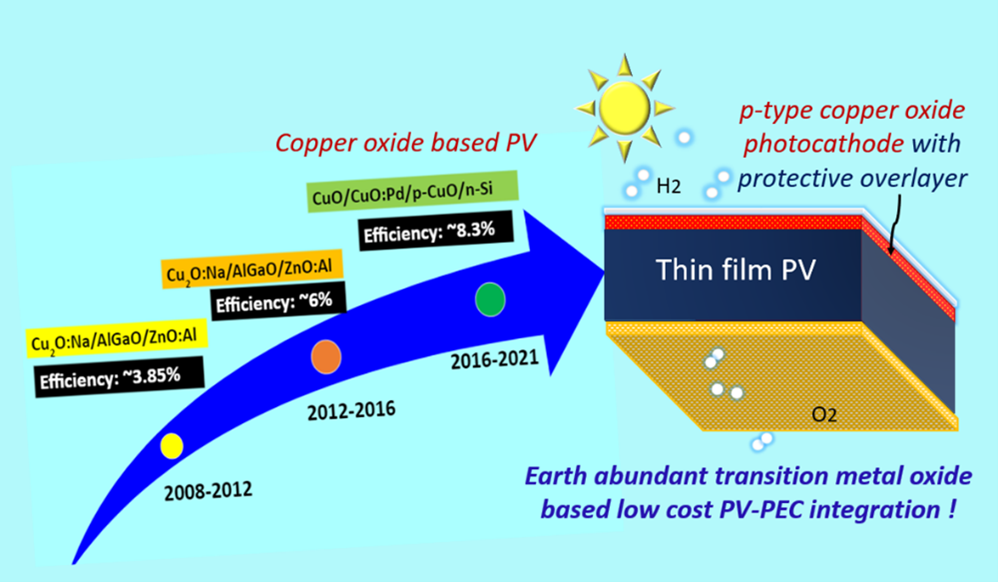 Solar light-driven hydrogen generation via water splitting is essential to combat global warming and CO2 emission. The production of hydrogen from fossil fuels produces massive amounts of CO2. Developing a sustainable and eco-friendly approach to hydrogen production is the need of the hour. Photoelectrochemical water splitting is a clean way to produce hydrogen by using water. The hydrogen generated through water splitting is referred to as Green Hydrogen. Photoelectrochemical water splitting uses metal oxides as photocathode/anode. The challenges that occur here are stability, low efficiency, and large-scale development (reusable electrodes are essential). Hence, the primary goal is to demonstrate photoelectrodes using different metal oxides by in-situ doping of different metals to detect the challenges.
Solar light-driven hydrogen generation via water splitting is essential to combat global warming and CO2 emission. The production of hydrogen from fossil fuels produces massive amounts of CO2. Developing a sustainable and eco-friendly approach to hydrogen production is the need of the hour. Photoelectrochemical water splitting is a clean way to produce hydrogen by using water. The hydrogen generated through water splitting is referred to as Green Hydrogen. Photoelectrochemical water splitting uses metal oxides as photocathode/anode. The challenges that occur here are stability, low efficiency, and large-scale development (reusable electrodes are essential). Hence, the primary goal is to demonstrate photoelectrodes using different metal oxides by in-situ doping of different metals to detect the challenges. - Three patent publications from the Department of CSE May 26, 2022
The Department of Computer Science and Engineering is pleased to announce the publication of three different patent applications from the department. The patent applications were submitted by the BTech students; Mr Kandala Sree Rama Murthy, Ms Padmaja Buggaveeti, Ms Yadlapalli Sai Harshini, Mr Jagruth K, Ms Shikha Chauhan, and Ms Ravi Srihitha under the guidance of Assistant Professor Dr V M Manikandan. They are making the institution proud with their passion and enthusiasm for the research domain.
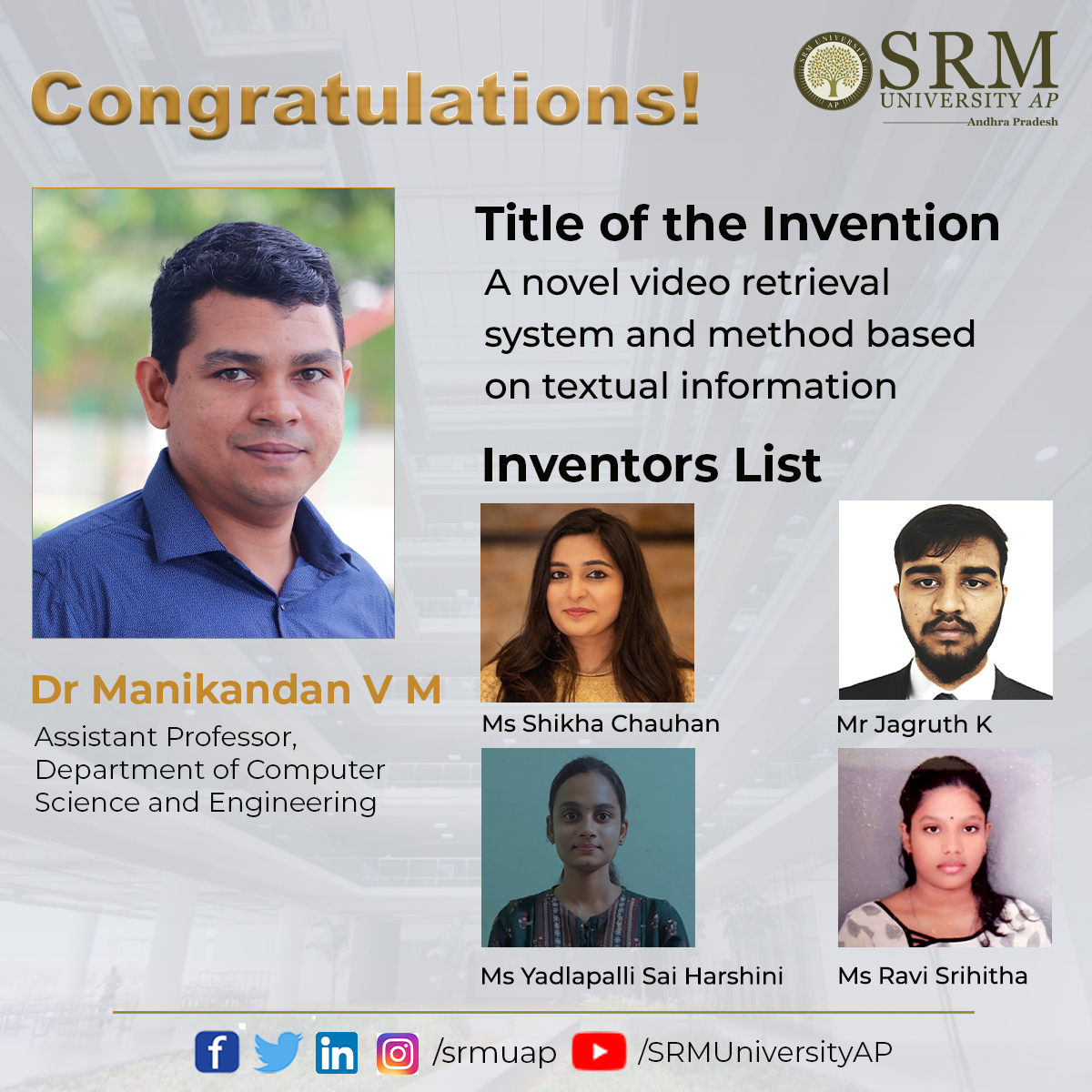 The invention of a new scheme that will help to retrieve relevant videos from a large pool based on the given keyword is an impressive concept with societal relevance. Dr V M Manikandan and BTech students; Ms Yadlapalli Sai Harshini, Mr Jagruth K, Ms Shikha Chauhan, and Ms Ravi Srihitha got their patent application titled A novel video retrieval system and method based on textual information (application number: 202241002653) published.
The invention of a new scheme that will help to retrieve relevant videos from a large pool based on the given keyword is an impressive concept with societal relevance. Dr V M Manikandan and BTech students; Ms Yadlapalli Sai Harshini, Mr Jagruth K, Ms Shikha Chauhan, and Ms Ravi Srihitha got their patent application titled A novel video retrieval system and method based on textual information (application number: 202241002653) published.The conventional video retrieval system uses the metadata to retrieve the appropriate videos. The new scheme processes the video and identifies the text information within the video, which will be compared with the given keyword. They introduced a scene change detection technique to select the frames for further processing in the new system to reduce the overall processing time.
The new scheme will help to retrieve appropriate educational videos from a large video pool based on the given keyword. The processing time is a significant concern in the scheme proposed. The researchers’ future work will be focused on improving the time complexity of the scheme.
 The other research team invented a prediction error histogram shifting-based approach to hide secret messages in a cover image. The patent application submitted by Dr V M Manikandan and Third-year BTech-CSE Student, Ms Padmaja Buggaveeti, is titled A reversible data hiding system and method for image transmission (application number: 202241002654). The method ensures the lossless recovery of the original image during data extraction. The researchers considered the overflow issues in the histogram shifting approach and proposed an efficient method to handle this.
The other research team invented a prediction error histogram shifting-based approach to hide secret messages in a cover image. The patent application submitted by Dr V M Manikandan and Third-year BTech-CSE Student, Ms Padmaja Buggaveeti, is titled A reversible data hiding system and method for image transmission (application number: 202241002654). The method ensures the lossless recovery of the original image during data extraction. The researchers considered the overflow issues in the histogram shifting approach and proposed an efficient method to handle this.Reversible Data Hiding (RDH) provides a way to embed some data in a selected image so that in the future, the hidden data can be extracted along with the recovery of the original image. The new RDH scheme invented by the researchers can be used in the healthcare sector to embed patient reports in medical images, or cloud service providers can use it to embed metadata in the digital data. Their future work will focus on designing and implementing robust reversible data hiding schemes capable of resisting attacks.
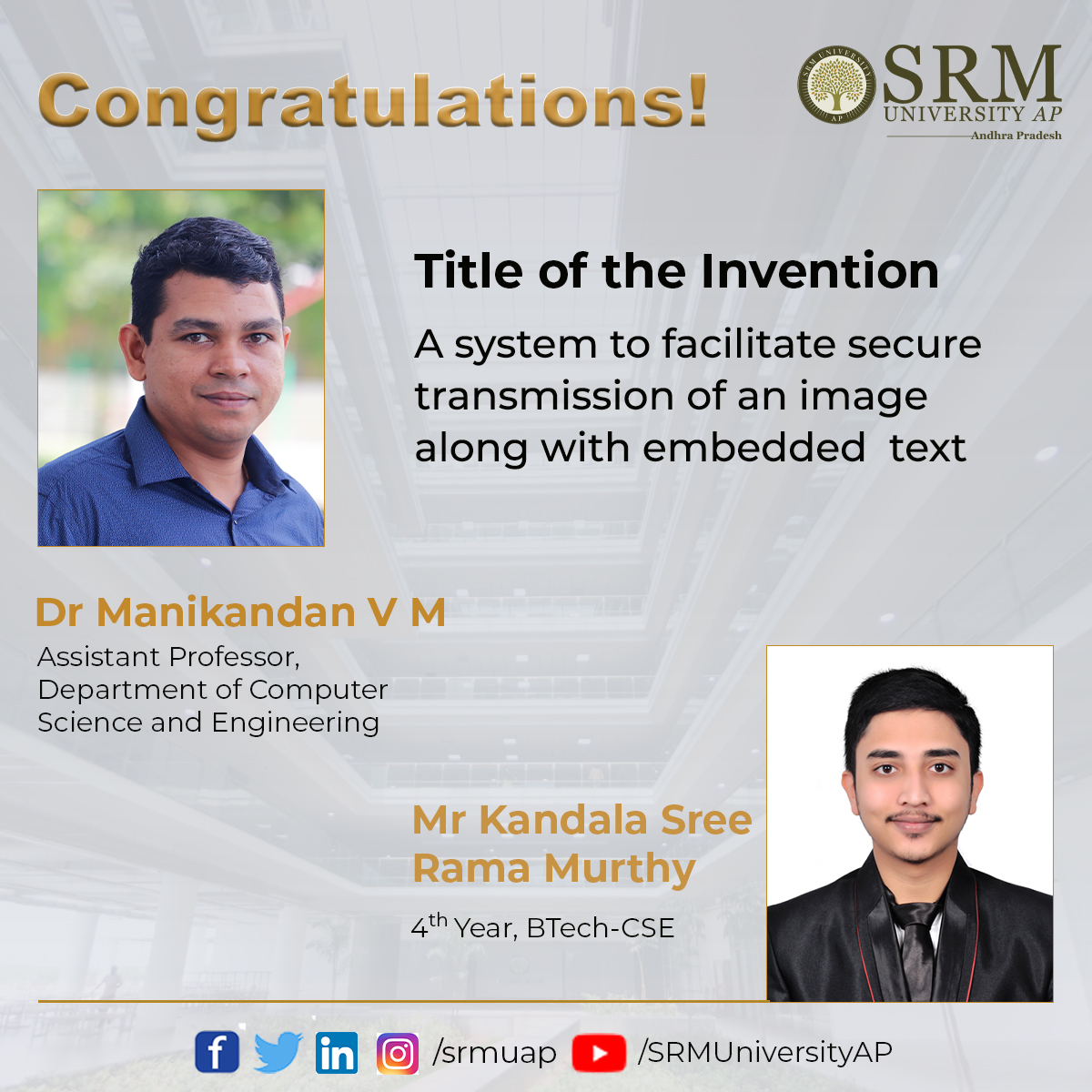 A system to facilitate secure transmission of an image along with embedded text (application number: 202241005221) is the third patent application that got published and was submitted by Dr V M Manikandan and Final year B.Tech-CSE Student Mr Kandala Sree Rama Murthy. The researchers invented a method to embed a message into a selected image during the image encryption process, which provides secure transmission of messages. The receiver will be able to extract the hidden message during decryption. The presented method is useful in medical image transmission to store patient details in the medical image.
A system to facilitate secure transmission of an image along with embedded text (application number: 202241005221) is the third patent application that got published and was submitted by Dr V M Manikandan and Final year B.Tech-CSE Student Mr Kandala Sree Rama Murthy. The researchers invented a method to embed a message into a selected image during the image encryption process, which provides secure transmission of messages. The receiver will be able to extract the hidden message during decryption. The presented method is useful in medical image transmission to store patient details in the medical image.The transmission of medical images and health reports from one hospital to another is widespread in the healthcare sector. Hospitals may want to handle many medical images and health reports every day and ensuring the one-to-one correspondence between them is a tedious task. The invented method will help embed health reports in medical images during encryption. The encrypted medical images (embedded with health reports) can be transmitted securely. The receiver will be able to extract the hidden message after medical image decryption. The researchers’ future work will focus on improving the invented method’s embedding capacity so that lengthy reports can be embedded into the medical images.
Continue reading →

